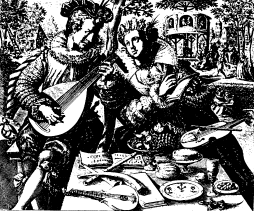The dance requirements of the English elizabethan courts required the services of Dancing Masters. Many of the dances originated in Europe, notably in Italy, France and Spain. The most famous Dancing Masters were Thoinot Arbeau (1520 – 1595 – French), Fabritio Caroso (1536 – 1605 – Italian) and Cesare Negri (1535-1604 – Italian).
These Elizabethan Dancing Masters each produced Dance Manuals which were printed and distributed. Various types of dance steps were included in these famous dance manuals including walking steps, cutting steps, sliding, stamping, leaping, jumping and hopping!

Influence of Queen Elizabeth I
Queen Elizabeth encouraged music and dancing amongst all of her subjects. She was a patron of all the Arts and encouraged the work of Elizabethan composers and musicians. She had been taught to play musical instruments as part of her education and was a skilled musician of the lute and the virginal. Her education also included learning to dance. Queen Elizabeth and her court used dance as a means of daily exercise.
In the morning she would perform as many as seven Galliards, one of the most demanding and energetic of all the Elizabethan dances. She continued this strenuous form of dancing until her late fifties! She expected all her courtiers to be proficient in dancing. The handsome Christopher Hatton was well known as one of the most accomplished dancers who the Queen admired. Her admiration of Christopher Hatton led to jealous fits from Robert Dudley, the Earl of Leicester.

Dudley was also a fine dancer and a wealthy patron of many Elizabethan composers and musicians. The court composers often named their works in honour of their patrons and the “Leicester Dance” was named accordingly.
Dances for the Lower Class
The Elizabethan Lower Classes were not in the position to hear the new court music or learn the intricate steps of the Court dances. Their only contact with these innovations, and as with the latest fashions, would have been through the theatres.
These English country dances were danced by couples in round, square, or rectangular sets in much simpler and repetitive forms and less intricate steps. The dances of the Elizabethan Lower Class would therefore be very different to those of the Elizabethan Upper Class. The dances would have been passed down through the generations and the different types of country dances were popular with everyone.

The dances of the Lower Classes would have been performed at fairs and festivals, many of which were dictated by the changing seasons and the calendar of Church events. Many of the dances of the Elizabethan Lower classes were steeped in old customs and rituals, such as dancing around the Maypole.
The Christmas festival included the carole which was the most popular dance-song which could be danced in a circle, or in a chain, or as a processional. Our modern Christmas Carols are derived from this practice.
List and description of Elizabethan Dances of the Lower Classes
- Brand, Brawle, Branle – the first dance often performed during celebratory gatherings and was also immensely popular as a concluding dance for masque revels. This circle dance featured sideways steps
- The Jig or Gigge aka Port – the jig traditionally involved ‘leaps’
- The Hornpipe – a lively dance resembling a jig which eventually became associated with sailors. Often accompanied by a pipe with a reed mouthpiece
- Roundel – Any dances which were performed in circle also called a ring-dance
- Dump, Dumpe or Dompe – Dance accompanied by the lute
- Buffoons – Comic characters who originally featured in ritual dancing such as Morris dances. The theme survived in the Buffoon country dance and also in court masques
- Maypole Dance – Dated back to the English pagan era where the maypole represented a symbol of fertility. Dancerkjihns dance in a circle each holding a coloured ribbon attached to a central pole
- Morris Dance – Often danced with handkerchiefs or sticks to embellish the hand movements
More Info On- Elizabethan Dances of Upper Classes, Dancing and music, Drama, England Music, Plays, Musical Instruments
